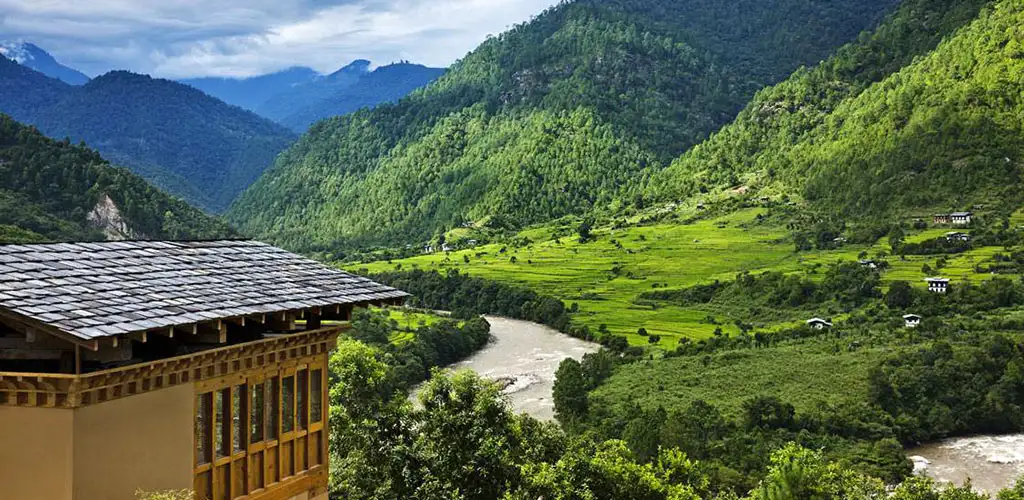The Wild East - Fringes of Bhutan
A Journey into Remote Bhutan
Since spending a month in Bhutan as a guest of the Queen a decade ago, I have traveled to many places in Africa, Asia and Latin America, and yet when people ask me the most beautiful country I've visited. I never hesitate to tell them Bhutan. A country, as you may know, created the concept of Gross National Happiness which is evident in the safeguarding of their culture and shepherding of their environment. The landscape is breathtaking, the dzongs aesthetically beautiful, and the Bhutanese culture rich and sustaining. A trip to Bhutan will be very high on your list as one of the most memorable trips of your lifetime.
The Himalayan Kingdom of Bhutan and in particular, the remote Eastern provinces, provide an untouched paradise of astonishing landscapes, from thick pine-forested mountains surrounding sublime valleys against the backdrop of the majestic snow-capped Himalayas.
Although, following a planned itinerary, the informal environment and unrushed schedule typically allows for flexibility for spontaneous, and authentic personal encounters throughout the trip, such as attending local celebrations.


THE WILD EAST TRIP ITINERARY
Getting There
Please contact us for international flight assistance and pre- and post-tour hotel and other arrangements. Bangkok is typically an ideal gateway for the start of this trip.
Day 1 | North America to Bangkok
Arrive with expedited immigration and overnight at Bangkok hotel.
Day 2 | Bangkok - Samdrup Jonkhar
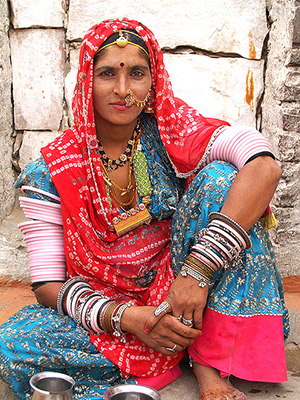
Fly direct from Bangkok to Guwahati, India. After arrival and clearing immigration (visa required), meeting with our local guide and driver and after a stroll around Old Guwahati, depart towards the border. En route stopping to visit to a small village, witnessing local life, including traditional silk weaving, the mainstay of the local economy.
Almost every house has an adjacent shed or karkhana that houses the traditional bamboo looms, the gentle click-clacking of which can be heard along the streets. Talented weavers create intricate patterns on gold ‘muga’, a rare wild silk that presents a striking tableau for photography this first day. Afterwards, driving to the border and after immigration formalities (Bhutan visa required), arrive into the busy border town of Samdrup Jongkhar, our final destination for the day.
Bangkok to Guwahati by Druk Airlines (1hr 30 minutes) Guwahati to border – by bus (about three hours) Overnight in local hotel
Day 3 | Samdrup Jonkhar - Trashigang
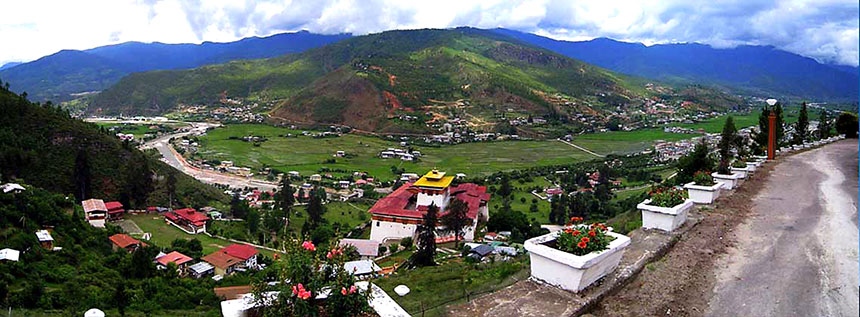
Today, depart early morning on an all-day overland journey to Trashigang, the largest city in Eastern Bhutan and main trading center with India. Leaving the plains behind, our drive ascends over several mountain passes, through tropical forests of teak and bamboo, terraced fields, and through smaller rustic villages where we will pause to explore. Here we may also stop at a handloom center in Khlaing, where we will meet with younger women who are trained in traditional backstrap weaving and natural dyeing. In the afternoon, arrive into Trashigang, our base for the next two nights.
Trashigang by van (112 miles, about six hours) Overnight in local inn.
Day 4 | Trashigang

In the morning, driving to Rangjung to enjoy a scenic leisurely trek through the verdant landscape and mountain vistas on the way to Saling village, pausing to admire the breathtaking views along the way. The area is home to a rare highland ethnic group called Dakpas, who live primarily in the twin villages of Merak and Sakteng. The 253-square-mile Sakteng Wildlife Sanctuary is near Trashigang, actually created in part to protect the migoi or as we know it, the mythical yeti. The area is home to a large variety of bird species including rufous-necked hornbill (Aceros nipalensis), Chestnut-breasted Partridge (Arborophila mandellii), and Pallas’s Fish eagle (Haliaeetus leucoruphus). En route, we will witness some raw silk weaving in the village of Radhi. In the afternoon, drive back to Trashigang and before dinner explore the city market and massive Dzong overlooking the Gamri-chuu River.
Day 5 | Trashigang - Lhuntse

Today we continue meandering through the mountain valleys and over passes towards Mongar, moving through the verdant forests and passing over the eight thousand foot Korila Pass. Along the way, pausing in small villages. We’ll see the rearing of lac on trees obtained from the scarlet resinous secretion of a number of species of insects, that produce various shades of red dye widely used in Bhutanese clothing.
We continue to Autsho where we will stay in a small family run guesthouse. In the afternoon, we arrive into Lhuntse, nearly fifty miles from Mongar, one of the most isolated regions in Bhutan with
spectacular landscapes featuring stark cliffs and gorges rich in dense coniferous forests. The area is known for its weavers producing textiles that are generally considered the finest in the country.
Autsho – Phayul Guest House
Day 6 | Lhuntse – Mongar
This morning, depart on an hour and half hike to Khoma, a pastoral village nestling in a valley in the Himalaya with traditional houses and cobbled stone courtyards that is renowned for the artistic weaving of complex and intricate patterns called Kushutara and Ngoshom, and are among the most expensive textiles in Bhutan.
Here is an ideal opportunity to meet and interact with the weavers many of whom work outside on backstrap looms in the paddy fields. In the afternoon, visiting with monks at the beautiful Lhuntse Dzong perched in the hill overlooking the expanses of the Lhunste valley. In the afternoon, drive to Mongar. Mongar marks the beginning of eastern Bhutan. The second largest town in the subtropical east, Mongar, like Trashigang further east, is situated on the side of a hill in contrasts to other towns of western Bhutan which are built on the valley floor.
Mongar Dzong is one of Bhutan's newest Dzongs, built only in 1930s, yet was built in the same way as ancient Dzongs without any drawings and no nails have been used. A visit to the Dzong gives visitors an impression of how traditional Bhutanese architecture has continued to thrive through the centuries.
Day 7 | Mongar - Bumthang

Today, traveling overland to central Bhutan along one of the most beautiful routes in the Himalayas crossing the 4,000 meter (12,300 foot) Thrumsingla Pass.
Traveling westwards winding into the beautiful setting of Bumthang in the heart of Central Bhutan, which consists of the four scenic mountain valleys of Ura, Chumey, Tang and Choekhor (also known as "Bumthang"). En route, stopping en route to visit Ura in the Ura Valley, a traditional village with a medieval feeling. After, we continue to Choekhor Valley, our base for the evening.
Overnight in Lodge
Day 8 | Bumthang

After breakfast, visiting the 7th-Century Jambey Lhakang, one of the oldest dzongs in Bhutan, and Kurje Lhakang where all the Kings of Bhutan are cremated. We then drive over the river to the Tamshing village and monastery. We'll also visit a local house and spend time in Jakar market with its eclectic mix of small open- fronted shops before moving on to stop by a farm sampling the local buckwheat noodle (putta), araa - a local wine - and salted butter tea. Late in the day, we will visit the splendid Jakar Dzong and explore the Chamkar bazaar before dinner.
Overnight in local lodge.
Day 9 | Bumthang - Trongsa
In the morning we drive to Trongsa, en route stopping to see the yatha weaving center at Zukney. Trongsa, one of Bhutan's oldest towns (its first monastery was built in 1543).
A highlight of a visit here is the magnificent dzong, which will occupy our afternoon as we photograph the the structure and spend time with resident monks. Constructed in 1644, it served as the original seat of power of the of the ruling dynasty of Bhutan. All kings of Bhutan are first given the title of penlop (governor) of Trongsa, and the first and second kings ruled from the town.
The main bazaar is situated along a striking lane of white traditional houses. It is a good place to break the journey from Thimphu to Jakar. In the afternoon, visit the Museum and Trongsa Dzong.
Overnight in hotel.
Day 10 | Trongsa - Punakha
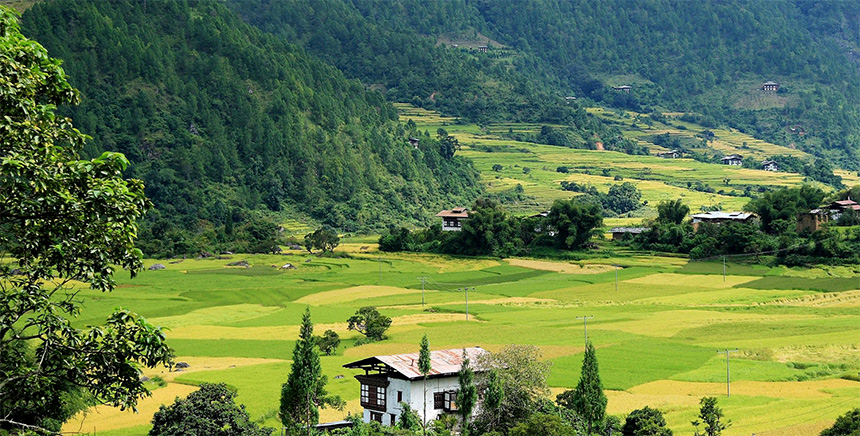
Today, drive to Punakha, en route visit the Chendibji chorten. (about 5 to 6 hrs). We will make frequent stop on the way for photography in local villages witnessing daily life.
After reaching Punakha, enjoying a short hike of about an hour through local farms, fields of mustard, and villages to the monastery, Chimi Lhakhang. The site was built in 1499 by the 14th Drukpa hierarch, Ngawang Choegyel, after the site was blessed by the "Divine Madman" the maverick saint Drukpa Kinley whose legacy was many legends about his unorthodox ways of teaching Buddhism by singing, humor, and outrageous behavior, often bizarre, shocking, and with sexual overtones. Yet Drukpa Kuenley is one of the most revered and followed saints in Bhutan, and his symbol – the phallus – will be noticed in various forms within Bhutanese houses and restaurants. One of the odd aspects of the temples is its place as a pilgrimage site for women who come seeking blessings for children and will receive a thump on the head by the presiding Lama with a 10-inch ivory, wood, and bone phallus as well as the bow and arrow supposedly used by the Divine Madman himself.
Punakha, the former capital of Bhutan until 1955, is a picturesque town surrounded with snowcapped Himalayan slopes known for the massive Punakha Dzong. Known in ancient times as the Druk Pungthang Dechhen Phrodang or “the palace of great happiness”, the Punakha Dzong was the second dzong to be built in Bhutan. The fortress-monastery was built in 1637 by Shabdung Nawang Namgyal in a commanding position at the confluence of the Po Chhu and Mo Chhu (Father and Mother rivers). It once served as the seat of the Kingdom's government and is now the winter home of Je Khempo, the head abbot of Bhutan, along with a retinue of about 1,000 monks.
Day 11 | Punakha
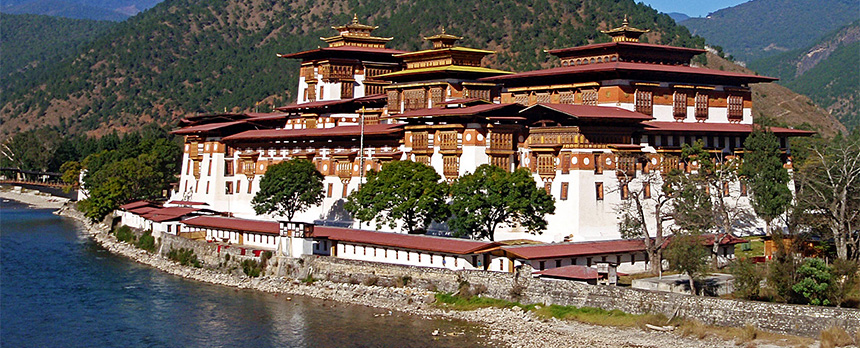
At the village of Nezigang, we hike up through cultivated fields and little hamlets to visit the Khamsum Yuley Namgay Chorten, a shrine built recently by the royal family. The shrine is an elaborate structure with a rainbow of Guru Rimpoche images and superb views of the Punakha Valley. We descend
and follow ancient riverside trails amid whitewashed farmhouses. We continue to Punakha and in the afternoon visit Bhutan's most recognized temple after the Tiger's Nest, the Punakha Dzong, arguably the most beautiful Dzong in the country. "Punthang Dechen Phodrang" (The Palace of Great Bliss) was built in 1637 by the Zhabdrung as a war fortress.
Today, it is the second oldest and second largest dzong in Bhutan and the dzong showcases the finest examples of Bhutanese arts and crafts along its walls and interiors.

Of special interest is the Kuenrey, a temple at the far end of the Dzong with awe-inspiring giant statues of the Buddha, flanked by the Guru and the Zhabdrung, and a ceiling of hundreds of beautifully painted dragons adorning it. Here are also the most beautiful paintings of the 12 episodes of the life of the Buddha (Zedpa Chuni).
Bhutan’s former winter capital, built in 1637 at the confluence of the Mo Chu and Po Chu (the Mother and Father rivers). The winter capital was established in this location in part because Punakha is a warm valley with a relatively low altitude of 4,100 feet, allowing for the production of two rice crops each year, along with oranges, mangos, and bananas.
After refreshing tea at the temples teahouse, return to resort for dinner and accommodation. The Punakha Dzong is an architectural wonder and seat of the head abbot of Bhutan. It has survived six fires, two glacial lake bursts, and an earthquake. This labyrinthine dzong has played a pivotal role in Bhutan’s history and has the official name of Druk
Pungthang Decchen Phodrang, which translates as “the palace of great happiness.” Overnight in the hotel Total Hiking Time: About 3 hours
Day 12 | Punakha - Thimpu

In the morning, driving to Thimphu (about three hours) over the spectacular Dochula, pausing to savor the expansive tableau of high peaks. In the afternoon after arrival, visiting the weekend market and photographing a traditional archery competition.
With a population just over 50,000, Thimphu is small and like no other capital city; set in a unique valley, with distinctive architecture reflective of the harmony of tradition and Jakar modernity. The capital Thimphu itself sprawls up the wooded western hillside of the Wang Chhu and is the center of government, but also religion and commerce. A city with no traffic lights where police still direct traffic at intersections, yet it is the largest city in the country and seat of the government as well as the main hub of commerce.
After hotel check-in, sightseeing in central Thimpu sights and shops by preference.
Thimpu's main cultural and historical attractions, include Institute of Traditional Medicine, School of Traditional Arts and Crafts, Folk Heritage and Textile Museums, and the Jungshina Handmade Paper Factory (Bhutan in ancient days was the biggest supplier of paper in the Himalayan region for printing religious scriptures and prayers). Next drive a short distance to the Sangaygang hill shrouded in hundreds of colorful flags with a great view over the capital city. Walk a short distance from here to the National Animal Sanctuary to see the unique Takin, the national animal. On the way back the bus will stop at the National Emporium.
Day 13 | Thimpu
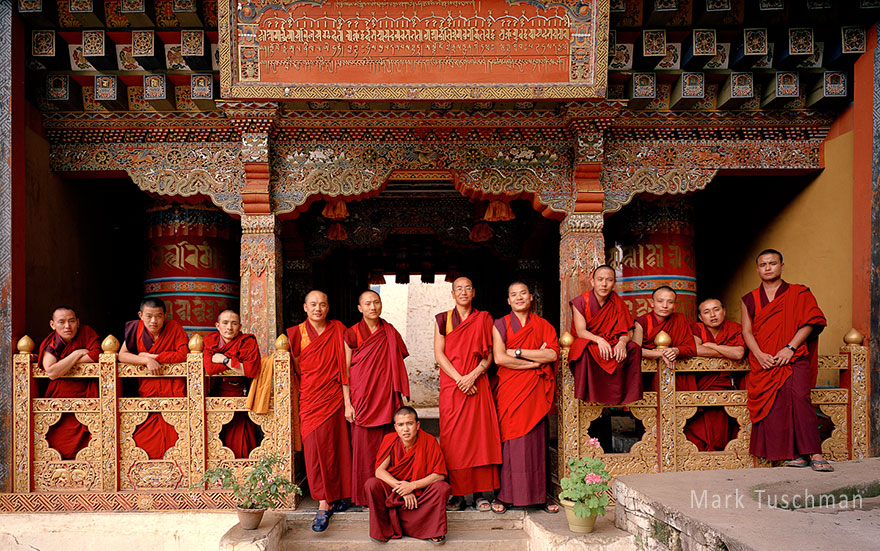
Today, driving a half hour north of Thimpu for a leisurely hike up to the Tango Monastery, a retreat built in 1688 and now serves as a university allowing visitors to have an intimate look into the daily life of a student of Buddhism. The student monks are kind and will invite us in for tea and snacks. The dzong is marked by impressive examples of Bhutanese architecture, finely crafted murals of Buddhist lineage (especially notable is the one of Jetsun Milarepa on the right wall to the main temple entrance) and there are sacred relics of the Drukpa lineage of Vajrayana Buddhism. We will visit the main temple and also linger in Tango’s inner courtyard, beautifully painted in bright colors, with lovely views stretching across the Thimphu Valley.
After visiting the monastery, return to Thimphu for lunch followed by afternoon, exploring highlights of the capital, including the Arts and Craft School which offers a comprehensive eight-year course in the techniques of traditional art in religious and secular paintings, woodcarving, clay sculpture and traditional mask making. We will meet and observe students working through progressive levels practicing the precise rules and traditions of Bhutanese art.

The Folk Heritage Museum is also an interesting museum place, set in an older traditional house. The museum is a walk through the changing rural traditions, habits and crafts, compared with those of the past.
In the evening the National Memorial Chorten is a pleasant setting to observe locals reciting prayers at dusk. The stupa was built in 1974 in memory of the third king of Bhutan.
Day 14 | Thimpu - Paro
After breakfast we will visit a local school during assembly before departing to Paro. After our short drive, exploring Paro, visiting the National Museum and Paro Dzong.
Paro is a beautiful valley encapsulating a rich local culture founded on hundreds of myths and legends, and bucolic landscapes. Mount Jumolhari (at over 7,300 meters) reigns in white glory at the northern end of the valley and its glacial waters plunge through deep gorges to form the Pa Chu (Paro River). It is home to many of Bhutan's oldest temples and monasteries, the country's only international airport and the National Museum.
Paro has hundreds of colorful Lhakhangs and Chortens, the most important being the famed Taktsang Monastery and Kyichu Lhakhang. Paro is also one of the most fertile valleys in the Kingdom, producing a bulk of the famous red rice from its terraced fields besides wheat, millet, potatoes, apple and seasonal vegetables. Most of the trade of Bhutan in olden times was conducted through Paro by way of a low pass, the Tremo La to Phari Dzong. In spring, thousands of families gather at Paro to celebrate the Paro Tshechu, a four day religious festival of mask dances and folk entertainment.
Day 15 | Paro
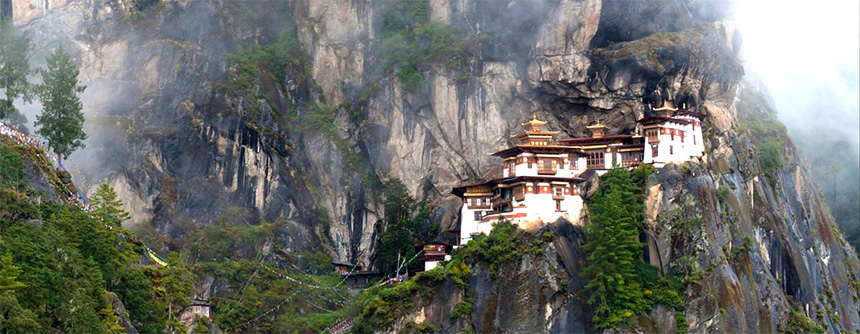
This morning we hike up through pine forests festooned with Spanish moss to reach to the striking monastic retreat “Tiger's nest monastery” — Taktsang Palphug — an image recognized around the world.
The picturesque symbol of Bhutan is one of the most sacred monasteries in the Himalayas. Originally erected in 1692, the temple hangs on a cliff at 3,120 meters (10,200 feet), some 700 meters (2,300 feet) above the bottom of Paro valley. The name Taktsang (stag tshang) means "Tiger's lair", legend being Padmasambhava (Guru Rinpoche) flew here on the back of a tigress, bringing Buddhism from Tibet.
Hiking to the monastery viewpoint takes about one hour and another hour and half to arrive at the temple itself, with our total hiking from about 7:30 to 11:30 AM (if time and energy level allow, we can head further up the mountain to visit other more remote temples and monasteries). After lunching nearby at the end of the hike, return to the Uma for relaxing or continue on an optional visit Drugyel Dzong, in the northern side of the valley, and the 8th-century Kyichu temple located there.
Tonight our farewell dinner and celebration in Paro, featuring a final presentation of some of our images.
Day 16 | Paro - Bangkok
After savoring a last sunrise over the valley and breakfast on the veranda, transfer to close by Paro Airport (ten minutes) and after farewells with guide, depart for Bangkok. After arrival in Bangkok, transit to connecting flight (no visa required).
Bangkok Arrival Procedures
Upon exiting aircraft, meet escort inside terminal area (escort will be holding a placard with your name) who will guide you through expedited Fastrack immigration*, baggage claim (escorted transfer may also be provided to hotel kiosk or connecting flight, by arrangement).
Log jay gay (see you again) and thank you for traveling with us!

TRIP DESIGNER MARK TUSCHMAN

A freelance photographer for over 35 years, Mark has devoted much of the past decade to documenting global health challenges and women’s human rights issues, in collaboration with UN agencies, socially
conscious corporations, foundations, and NGOs. His work has been featured at many international events, including at the Women Deliver Conference in 2013, and at the Carter Center’s Human Rights Defenders Forum in 2015. The Global
Health Council named Mark Photographer of the Year in 2010, and his images won the Grand Prize in a worldwide photo competition sponsored by the Social Documentary Network and Management Sciences for Health.
In the last two years Mark has visited rural India as part of a long term project to document women’s and young girls’ lack of autonomy over their own lives. An exhibition of this project, India: Child Brides, Dowry Abuse and Girls’ Education, took place at the World Affairs Council in San Francisco and was co-sponsored by Educate Girls. Please view images from this project in Mark's India Web Gallery and interview on YouTube. His most recent project is a book fully funded on Kickstarter: Faces of Courage: Intimate Portraits of Women on the Edge and is completing a book on his images of Bhutan. Mark also loves landscape photography, with work featured in a Rangefinder.
Mark has lead several of our past trips including Myanmar, Vietnam, and Cambodia but his experience and connections in Bhutan are the most compelling. His blog and photos, including Bhutan Photo Gallery from our previous trips.
Tour Cost
From $7,590 (per person-double occupancy) Single Accommodation: $1,425
Trip Fees Include
-
Bangkok to Guwahati Airlines
-
Paro to Bangkok Airlines
-
Required Visas
-
Airport transfers
-
Accommodation based on double occupancy in hotels
listed or similar
-
All meals, bottled water, and tea
-
Transportation by private coach throughout
-
Expert local guides for sightseeing
-
All activities and entrance fees
-
Tour accompanied by our English speaking tour manager,
specialized in photography
-
Gratuities for group activities, including meals, hotels,
guides
-
Taxes (as indicated above)
-
Pre- and Post-trip travel assistance
Not Included:
-
International airfare (may be arranged through us)
-
Meals other than those mentioned above
-
Beverages aide from tea and water
-
Excess baggage charges
-
Items of a personal nature
-
Travel insurance (ask us for a quote)
Payment Details:
A non-refundable deposit of US$2,500 per person is required to reserve a private tour. Balance of tour cost is due 90 days before departure (read all of our Terms & Conditions). Travel cancellation and delay insurance is highly recommended. Please request a quote at time of booking.
What to Expect
Level of Activity
A good level of fitness is important for this trip as we will be traveling at high altitudes over 8,000 feet with a generous amount of walking and light trekking. This trip is not appropriate for those with heart, respiratory, circulatory disorders, or reduced mobility.
Accommodation
We are staying in clean and comfortable basic guesthouses until reaching Bumthang where there are luxury hotel options including Aman, Uma, and Six Senses Bhutan properties [Visit our hotels page]
Transportation
You will be traveling in a comfortable, spacious, air conditioned van. Road conditions in this region of Bhutan are poor and you should expect slow travel with some delays.
Weather
Bhutan’s climate is greatly determined by elevation. April is generally warm and sunny with flowers beginning to bloom in the mountains and Fall is also a good time to travel this itinerary.
Currency
Rupees and BTN can be exchanged upon arrival.
Visas
Visas are required for both India and Bhutan.
Telecommunications
Bhutan enjoys a robust GSM cell phone access for roaming mobile phones in almost the entire region between Paro and Punakha, but in Eastern Bhutan our reception for both mobile and Internet access will be very limited.
Post-trip
Bhutan combines well with wonderful Myanmar, location of our previous photography trip, or the magnificent temples at Angkor, a short hop from Bangkok.

